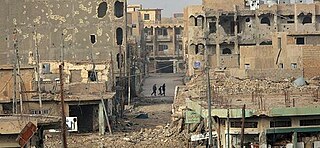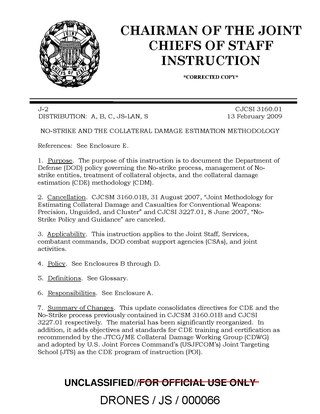
A war crime is a violation of the laws of war that gives rise to individual criminal responsibility for actions by combatants in action, such as intentionally killing civilians or intentionally killing prisoners of war, torture, taking hostages, unnecessarily destroying civilian property, deception by perfidy, wartime sexual violence, pillaging, and for any individual that is part of the command structure who orders any attempt to committing mass killings including genocide or ethnic cleansing, the granting of no quarter despite surrender, the conscription of children in the military and flouting the legal distinctions of proportionality and military necessity.

A cluster munition is a form of air-dropped or ground-launched explosive weapon that releases or ejects smaller submunitions. Commonly, this is a cluster bomb that ejects explosive bomblets that are designed to kill personnel and destroy vehicles. Other cluster munitions are designed to destroy runways or electric power transmission lines.

A civilian casualty occurs when a civilian is killed or injured by non-civilians, mostly law enforcement officers, military personnel, rebel group forces, or terrorists. Under the law of war, it refers to civilians who perish or suffer wounds as a result of wartime acts. The term is generally applied to situations in which violence is committed in pursuit of political goals. During periods of armed conflict, there are structures, actors, and processes at a number of levels that affect the likelihood of violence against civilians.

Iraq Body Count project (IBC) is a web-based effort to record civilian deaths resulting from the US-led 2003 invasion of Iraq. Included are deaths attributable to coalition and insurgent military action, sectarian violence and criminal violence, which refers to excess civilian deaths caused by criminal action resulting from the breakdown in law and order which followed the coalition invasion. As of February 2019, the IBC has recorded 183,249 – 205,785 civilian deaths. The IBC has a media-centered approach to counting and documenting the deaths. Other sources have provided differing estimates of deaths, some much higher. See Casualties of the Iraq War.

Estimates of the casualties from the Iraq War have come in several forms, and those estimates of different types of Iraq War casualties vary greatly.
International humanitarian law (IHL), also referred to as the laws of armed conflict, is the law that regulates the conduct of war. It is a branch of international law that seeks to limit the effects of armed conflict by protecting persons who are not participating in hostilities and by restricting and regulating the means and methods of warfare available to combatants.

The Iraqi civil war was an armed conflict from 2006 to 2008 between various sectarian Shia and Sunni armed groups, such as the Islamic State of Iraq and the Mahdi Army, in addition to the Iraqi government alongside American-led coalition forces. In February 2006, the insurgency against the coalition and government escalated into a sectarian civil war after the bombing of Al-Askari Shrine, considered a holy site in Twelver Shi'ism. US President George W. Bush and Iraqi officials accused Al-Qaeda in Iraq (AQI) of orchestrating the bombing. AQI publicly denied any links. The incident set off a wave of attacks on Sunni civilians by Shia militants, followed by attacks on Shia civilians by Sunni militants.
During the War in Afghanistan, according to the Costs of War Project the war killed 176,000 people in Afghanistan: 46,319 civilians, 69,095 military and police and at least 52,893 opposition fighters. However, the death toll is possibly higher due to unaccounted deaths by "disease, loss of access to food, water, infrastructure, and/or other indirect consequences of the war." According to the Uppsala Conflict Data Program, the conflict killed 212,191 people. The Cost of War project estimated in 2015 that the number who have died through indirect causes related to the war may be as high as 360,000 additional people based on a ratio of indirect to direct deaths in contemporary conflicts.
Marc Garlasco is an American military advisor for the Dutch non-governmental organization PAX. Early in his career, Garlasco served for seven years at the Pentagon, as a mid-level intelligence analyst, later becoming chief of high-value targeting. Garlasco left in 2003 and joined Human Rights Watch (HRW) as a senior military expert, where he investigated human rights issues in a number of different conflicts zones. He resigned from HRW in February 2010 and has since worked as a specialist on civilian protection, war crimes investigations, identification of weapons and civilian harm mitigation for – among others – the United Nations, the Center for Naval Analysis (CNA), the International Committee of the Red Cross (ICRC), before starting at PAX in 2020. Garlasco lives in New York.
Military necessity, along with distinction, and proportionality, are three important principles of international humanitarian law governing the legal use of force in an armed conflict.
The Uppsala Conflict Data Program (UCDP) is a data collection program on organized violence, based at Uppsala University in Sweden. The UCDP is a leading provider of data on organized violence and armed conflict, and it is the oldest ongoing data collection project for civil war, with a history of almost 40 years. UCDP data are systematically collected and have global coverage, comparability across cases and countries, and long time series. Data are updated annually and are publicly available, free of charge. Furthermore, preliminary data on events of organized violence in Africa is released on a monthly basis.
In armed conflicts, the civilian casualty ratio is the ratio of civilian casualties to combatant casualties, or total casualties. The measurement can apply either to casualties inflicted by or to a particular belligerent, casualties inflicted in one aspect or arena of a conflict or to casualties in the conflict as a whole. Casualties usually refer to both dead and injured. In some calculations, deaths resulting from famine and epidemics are included.

The Syrian civil war is an ongoing multi-sided conflict in Syria involving various state-sponsored and non-state actors. In March 2011, popular discontent with the rule of Bashar al-Assad triggered large-scale protests and pro-democracy rallies across Syria, as part of the wider Arab Spring protests in the region. After months of crackdown by the government's security apparatus, various armed rebel groups such as the Free Syrian Army began forming across the country, marking the beginning of the Syrian insurgency. By mid-2012, the crisis had escalated into a full-blown civil war.

War crimes in the Syrian civil war have been numerous and serious. A United Nations report published in August 2014 stated that "the conduct of the warring parties in the Syrian Arab Republic has caused civilians immeasurable suffering". Another UN report released in 2015 stated that the war has been "characterized by a complete lack of adherence to the norms of international law" and that "civilians have borne the brunt of the suffering inflicted by the warring parties". Various countries have prosecuted several war criminals for a limited number of atrocities committed during the Syrian civil war.

War crimes and human rights violations, committed by all warring parties, have been widespread throughout the Yemeni civil war. This includes the two main groups involved in the ongoing conflict: forces loyal to the current Yemeni president, Abdrabbuh Mansur Hadi, and Houthis and other forces supporting Ali Abdullah Saleh, the former Yemeni president. Al-Qaeda in the Arabian Peninsula and the Islamic State of Iraq and the Levant have also carried out attacks in Yemen. The Saudi-led coalition, backed by the United States and other nations, has also been accused of violating human rights and breaking international law, especially in regards to airstrikes that repeatedly hit civilian targets.

Action on Armed Violence (AOAV) is a London-based charity, conducting research and advocacy on the incidence and impact of global armed violence.
The 20-year-long War in Afghanistan had a number of significant impacts on Afghan society.

Non-combatant casualty value (NCV), also known as the non-combatant and civilian casualty cut-off value, is a military rule of engagement which provides an estimate of the worth placed on the lives of non-combatants, i.e. civilians or non-military individuals within a conflict zone. It has become an element of strategic planning and policy-making during a number of armed conflicts, providing a quantification of the proportionality principle as interpreted by the military command, and thus influencing decisions regarding the use of force and "acceptable" collateral damage. It has been described as a "central value in contemporary Western war" and "perhaps our starkest rule of engagement".












